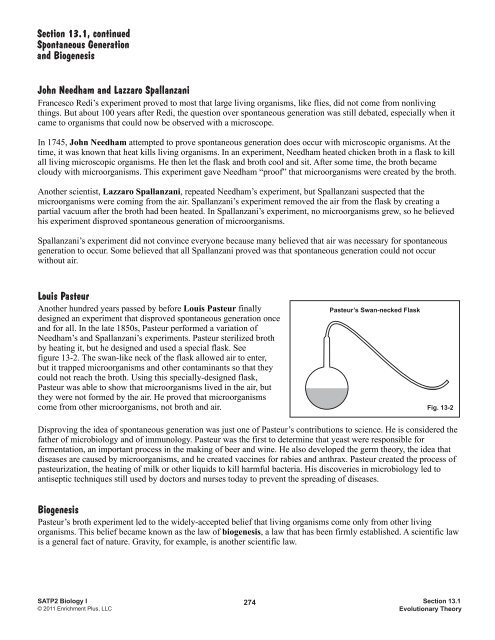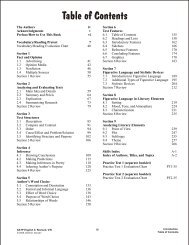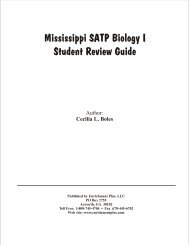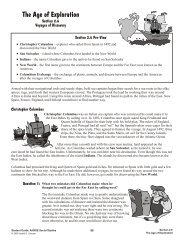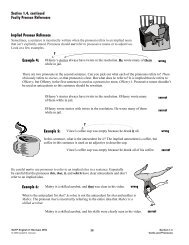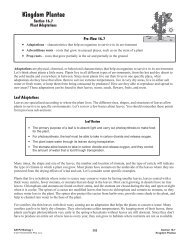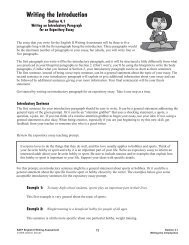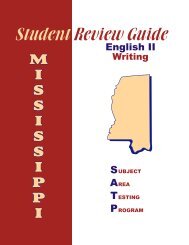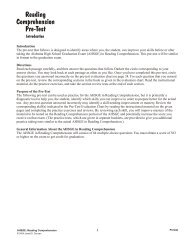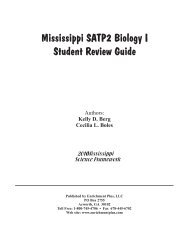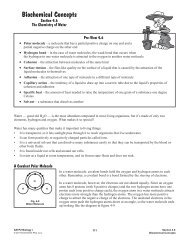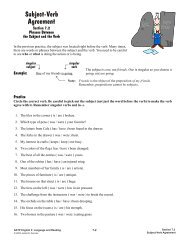Mississippi SATP2 Biology I Student Review Guide - Enrichment Plus
Mississippi SATP2 Biology I Student Review Guide - Enrichment Plus
Mississippi SATP2 Biology I Student Review Guide - Enrichment Plus
Create successful ePaper yourself
Turn your PDF publications into a flip-book with our unique Google optimized e-Paper software.
Section 13.1, continued<br />
Spontaneous Generation<br />
and Biogenesis<br />
John Needham and Lazzaro Spallanzani<br />
Francesco Redi’s experiment proved to most that large living organisms, like flies, did not come from nonliving<br />
things. But about 100 years after Redi, the question over spontaneous generation was still debated, especially when it<br />
came to organisms that could now be observed with a microscope.<br />
In 1745, John Needham attempted to prove spontaneous generation does occur with microscopic organisms. At the<br />
time, it was known that heat kills living organisms. In an experiment, Needham heated chicken broth in a flask to kill<br />
all living microscopic organisms. He then let the flask and broth cool and sit. After some time, the broth became<br />
cloudy with microorganisms. This experiment gave Needham “proof” that microorganisms were created by the broth.<br />
Another scientist, Lazzaro Spallanzani, repeated Needham’s experiment, but Spallanzani suspected that the<br />
microorganisms were coming from the air. Spallanzani’s experiment removed the air from the flask by creating a<br />
partial vacuum after the broth had been heated. In Spallanzani’s experiment, no microorganisms grew, so he believed<br />
his experiment disproved spontaneous generation of microorganisms.<br />
Spallanzani’s experiment did not convince everyone because many believed that air was necessary for spontaneous<br />
generation to occur. Some believed that all Spallanzani proved was that spontaneous generation could not occur<br />
without air.<br />
Louis Pasteur<br />
Another hundred years passed by before Louis Pasteur finally<br />
Pasteur’s Swan-necked Flask<br />
designed an experiment that disproved spontaneous generation once<br />
and for all. In the late 1850s, Pasteur performed a variation of<br />
Needham’s and Spallanzani’s experiments. Pasteur sterilized broth<br />
by heating it, but he designed and used a special flask. See<br />
figure 13-2. The swan-like neck of the flask allowed air to enter,<br />
but it trapped microorganisms and other contaminants so that they<br />
could not reach the broth. Using this specially-designed flask,<br />
Pasteur was able to show that microorganisms lived in the air, but<br />
they were not formed by the air. He proved that microorganisms<br />
come from other microorganisms, not broth and air. Fig. 13-2<br />
Disproving the idea of spontaneous generation was just one of Pasteur’s contributions to science. He is considered the<br />
father of microbiology and of immunology. Pasteur was the first to determine that yeast were responsible for<br />
fermentation, an important process in the making of beer and wine. He also developed the germ theory, the idea that<br />
diseases are caused by microorganisms, and he created vaccines for rabies and anthrax. Pasteur created the process of<br />
pasteurization, the heating of milk or other liquids to kill harmful bacteria. His discoveries in microbiology led to<br />
antiseptic techniques still used by doctors and nurses today to prevent the spreading of diseases.<br />
Biogenesis<br />
Pasteur’s broth experiment led to the widely-accepted belief that living organisms come only from other living<br />
organisms. This belief became known as the law of biogenesis, a law that has been firmly established. A scientific law<br />
is a general fact of nature. Gravity, for example, is another scientific law.<br />
<strong>SATP2</strong> <strong>Biology</strong> I<br />
© 2011 <strong>Enrichment</strong> <strong>Plus</strong>, LLC<br />
274<br />
Section 13.1<br />
Evolutionary Theory


